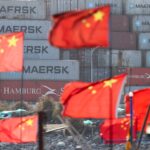
AUD & NZD: Navigating Turbulence Amid Global Uncertainty
Tháng 4 4, 2025
China’s Strategic Shift: Navigating U.S. Tariffs with Economic Resilience
Tháng 4 4, 2025Recent Developments in U.S. Tariffs and Negotiations
On April 2, 2025, President Donald Trump made headlines with a significant announcement regarding U.S. trade policy by introducing a 10% global tariff on all imports entering the United States, starting April 5, 2025. This move marks a notable shift in the U.S. approach to trade, reflecting a broader strategy that encompasses various economic implications and negotiations with foreign nations. Moreover, an increased reciprocal tariff ranging from 11% to 50% will affect 57 countries, specifically those designated for nonreciprocal trade practices, beginning April 9, 2025.
The Implications of Trump’s Tariff Strategy
President Trump’s recent tariff initiatives aim to reshape the international trade landscape by encouraging reciprocation from trading partners. The administration has indicated that this strategy is not merely a punitive measure, but a tactical leverage point for enhancing bilateral negotiations. Historically, similar tactics have proven effective; for instance, in the negotiations with Canada and Mexico, the imposition of tariffs served as a catalyst for constructive dialogues, ultimately resulting in favorable outcomes.
These tariffs are designed not only to address existing trade deficits but also to stimulate a shift toward more equitable trade practices, compelling countries to engage more fairly in the trade dynamics. By imposing these tariffs, the Trump Administration signals that it is willing to initiate conversations that could lead to better trading conditions. This dual approach fosters a delicate balance between pressure and negotiation, ensuring that the U.S. retains its competitive edge while pursuing advantageous deals. As highlighted by China’s President Xi Jinping, discussions among top global CEOs further illustrate the importance of international collaboration in navigating the complexities of global trade.
Openness to Negotiation
A recent report by ForexLive emphasizes that despite the forthcoming tariffs, President Trump remains open to negotiations with foreign governments. This suggests a nuanced understanding of trade relations, where tariffs serve as a tool for diplomacy rather than mere economic regulation. The global trade environment is fraught with complexity, and having tariffs in place could lead to discussions that might otherwise not have occurred. As the Trump Administration navigates this intricate landscape, there is an implicit acknowledgment that negotiations will play a critical role in determining the ultimate success of these tariffs.
The prospect of using tariffs as a bargaining chip indicates a strategic pivot that could yield substantial economic benefits for the U.S. if managed effectively. While it remains to be seen how each affected country will respond to these measures, the potential for dialogue introduces an element of optimism amid uncertainty. In the era where global economies are interconnected more than ever, such tariff strategies remain pivotal in shaping the future of international trade relations.
In summary, President Trump’s latest tariff strategy illustrates a multifaceted effort to improve U.S. trade standing while leaving room for possible negotiations. As the implementation dates for these tariffs draw closer, the world watches closely, considering the myriad ways these policies could impact global trade dynamics. The emphasis on reciprocal arrangements and ongoing discussions marks a significant chapter in U.S. trade policy, with implications that could resonate well beyond April 2025.

